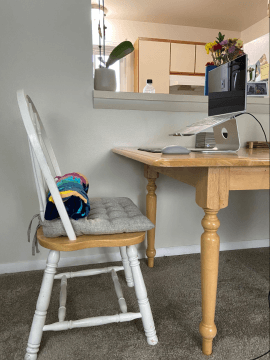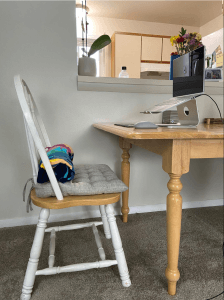How Ergonomists Work from Home
07/07/2020

As many of us continue to work from home, you might be wondering how to improve your home-office setup. Maybe you’re missing some of the equipment from the office and are stumped on how to overcome that barrier in order to optimize the ergonomics of your workspace. We’ve asked some Humantech employees about their home setups and barriers as a benchmark and a way to brainstorm creative solutions. We found some common themes; many of us have had to grapple with less-than-perfect desk and chair setups, working with only a laptop screen or one small external monitor, and maintaining a balance between “work” and “home” life.
Workstation set up
up
We all have access to different things right now. Some of us were able to take our office chair home and others are sitting in a dining room chair at the kitchen table. The adjustability and customization we had access to in the office may not be available at home, but there are ways to set up your current workstation so that you can maintain neutral postures.
- Place a towel or pillow behind you to move forward on your chair if the seat pan is too deep. Make sure the edge of the seat does not press into the backs of your thighs or calves.
- Boost yourself up with a pillow if your desk is too high. If you can’t raise your chair or lower your desk, this is a great way to maintain neutral arm postures while working.
- For foot support, stack books underneath them if your feet don’t reach the floor.
- If the armrests on your chair are not adjustable, don’t use them. Instead, keep your elbows close to your body to allow a more relaxed posture throughout the day.
- If you can, borrow a chair from the office!
Productivity
The line between “work” and “home” may have become a bit blurred, as home is now where you work. Try some of these tips throughout the day:
- While brainstorming or on a phone call, work in a more casual setting, like the couch, or walk around the house. This will get you up and moving, rather than sitting in one spot all day long.
- Go on walks mid-day. This can break up the day and it’s especially beneficial to get out outside for fresh air!
- If walks are out of the question, work outside on a deck or balcony for a change of scenery.
- Designate a room (even if it’s a large closet) to function exclusively as an office. This will give you separation from the areas where you relax, creating more of a boundary between “work” and “home.”
- Remove clutter from your workstation. If your workspace is in a common living area, like the kitchen table, keeping the surface clear and organized can help you maintain focus.
Working from a laptop is hard
In the office, we may have used two or three different monitors at a time. At home, a lot of us have had to make do with only a small laptop screen. With everyone working from home, external monitors have been in high demand, so finding one to purchase has been a challenge. If you haven’t been able to find one:
- Use multiple desktops to mimic the effect of having an additional monitor. Windows + Tab will do the trick on a PC. Swiping up with three or four fingers or pressing the Mission Control button (usually located on the top panel) will get you there on a Mac. This helps, especially when multiple applications are open and things feel cluttered.
- Another keyboard shortcut is Alt + Tab to switch between programs easily. If your computer doesn’t have multiple desktop capabilities, this is a nice trick to control the clutter as well.
- Minimize whatever you’re working on to create a split screen. This also mimics the effect of having an additional monitor, especially when you’re working between applications and need to transfer information quickly.
These tips are bound to keep you safe, productive, and happy working from home.






